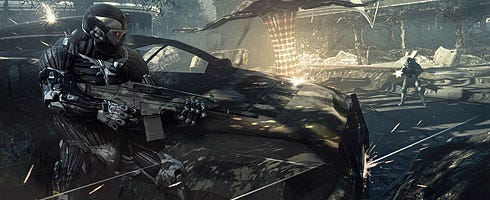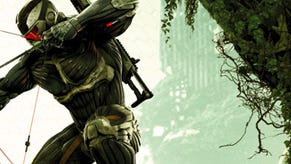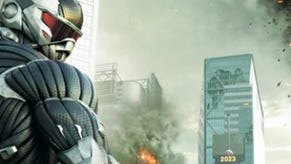Interview: Cevat Yerli on narrative in Crysis 2 (part 2)
EA reckons Crysis 2 might be one of the biggest games of 2010. EA might well be right, and for more than one reason. While the title is obviously spectacular on a tech level, as proven in a first trailer and initial gameplay showing last week, Crytek's convinced it'll set a new benchmark in games-based storytelling, showing seriousness of intentions by hiring celebrated sci-fi author Richard Morgan to pen the plot. Narrative is a major concern in Crysis 2's development; we figured it deserved its own interview.
While we got the chance to speak to Crytek boss Cevat Yerli immediately after the game's New York reveal last week, we were gifted another session with the exec the following day. The first interview was held in a packed room and focused more on the shooter sequel's most immediate aspects, but the second chat took place in a quiet hotel lobby and dwelt on story only. See what happened below.
[Interview by Patrick Garratt]
I’m really intrigued as to why you feel that the way forward for Crysis is narrative. You’ve got the Nanosuit and you’ve got New York and those are logical extensions of Crysis, right?
Cevat Yerli: Yes.
Crysis was always about the Nanosuit and it was always about the environment. Why do you feel that narrative is so important to first-person shooting?
Cevat Yerli: Nobody has cracked the nut yet, to be honest. I mean, there are great games and I don’t want to sound arrogant here; when I say that no one has cracked the nut, I think nobody has cracked the nut as I believe it could be done yet. But also I believe it needs to have collaboration with somebody that can put the words out, somebody that can drive it in technology with a synergistic affect. So far, games have always taken the writer approach, in giving either the hero of the cast a set of lines of dialogue to talk to deliver a story. In Crysis 1 I started a piece of ambient storytelling, where you see a lot of bits and pieces that are supposed to talk a lot. By “talk” I mean that when you see it, you’re like, “Oh my God, look what’s happening.” You interpret it, but there’s no talking going on. So, with Richard, I said to him, “You have three things to do. One is to experience the story. Second is to show it. Third is tell it.” Minimum telling, a little bit more showing, but we had to maximize the interactive experience of the story.
How did this translate? Effectively, when he writes a book, he would describe the world, yeah? He would give the reader the temperature, or describe the atmosphere. What I’m asking him to do is to put those words up in the air. Just fill it, and then we place in the effects of temperature and whatnot.
I also think that narrative execution in the form of first-person experience is the only hope we honestly have, if done right, to go through the game in a way a player thinks he’s fully gratified because he makes choices in the sandbox, but yet story and narration is developing as he goes and it pulls him forward. As Richard said, it resolves the mystery of falling; it gives you some grips here and there, but new things fall under your feet and you keep moving forward. In Crysis 1, narration didn’t do this. Hence people restarted the game died, rebooted, died, rebooted. Then after ten times of having fun, they said, “Why am I doing this again?” They’d lost track. If I look at the perceived experience of Crysis 1, I saw that both for Crysis and the first-person genre, here’s an opportunity where we can really push technical and creative excellence in storytelling, by pushing the boundaries of how we tell it and also how we package it, how we experience it. Frankly, it’s about minimizing the words, as opposed to writing words, but I want his mind to come in and say, “Here’s New York, here’s this, here’s that; how would I tell it? How would I write it?” Then he would explain how to experience it, as if you were there, and then describe it. And then we put it in the world.
It’s really more about a lens, not about writing.
Do you think that narration-free, gameplay-only shooter experiences are going to become a thing of the past?
Cevat Yerli: We are in a very lucky situation to have found Richard. Richard is a gamer, so he understands games as a consumer. The challenge, of course, in our collaboration is that we tell him, “That won’t work, Richard. We can’t do that.” It’s this creative friction that builds the experience, because we need to maximize what Richard can bring to the table into something we can maximize through technology.
For me, I think, after this game and other games doing similar things, games were narration or writing or novels are not part of it from the outset, those games are going to be obsolete, I believe. I’m quite convinced about that.
With Far Cry, we just slapped the story on later after we’d done the game, you know? [laughs] We just finished the game and said, “What’s the journey? Well, let’s see; what do you do here?” We put it in afterwards. In Crysis, we wrote the story, but we had, like, 25 cast and whatnot. The screen-time alone is not enough to build any character whatsoever.
In Crysis 2 we decided to do it from the outset, that it would be part of everything we do. Hence, Nanosuit, New York: the location has an arc, the Nanosuit has an arc. It’s not just that I read a book and everything has an arc; it’s to make sure the player is driven by the arc. I want to know what the deal is with Nanosuit 2. I want to know what the deal is with New York. And I want to know why the heck the aliens are here and where they come from. I want to know why the humans are shooting at me. These are all questions that are going to be asked and answered as you go through the journey, but that’s going to pull you through the game without you thinking it’s more fun to shoot the aliens or the humans than experiencing the story. I want the story to outpace the gameplay experience. I said to Richard, “Your challenge is to outpace the gameplay.” In Crysis, the story didn’t outpace the gameplay and people lost it. That’s the number one challenge.
Do you think there’s a danger that you may step away a little from the aspects the hardcore are most concerned about? Things like AI, pace…
Cevat Yerli: Absolutely not. Narration means narrowing, linearising, the story-line. I told Richard to not use this internally, to not use “narration” or “story-line”. Don’t bring it up to a line. It’s more like story points. It’s ambient story. It’s world-enrichment. I’m interested in telling a fiction by experiencing it. If I see, for example, that we have a script for a cut-scene, I say, “OK, translate that into experience, please.” Then we have proposals and then say, “OK, we’re going to do this and this and this.” By translating it into a world experience, it becomes a part of the sandbox and it becomes part of the game, and I pick it up on demand, in my own interests and in my own time.
What to you think of other narrative-based games, such as Uncharted 2? It’s very linear, right?
It’s another style.
It’s delivered in a very linear way.
Cevat Yerli: It’s another style, and I don’t want to talk down that game. It’s really great, and that’s an alternative style, but I don’t think they do justice to the medium of game. I think Mass Effect 2 is doing a better job to the game market, although it’s a completely different style to us, rather than Uncharted 2 or Modern Warfare, for that matter. It’s very [makes motion indicating a row of points]: it works, but that’s not our style.
Our style is still going to be fast-paced and intense, but our style is going to be about the world, much more like Avatar with Pandora. The story, the line was not interesting and we will have an interesting line, but the world was awesome. That’s what I’m much more interested in: depicting a great world.
Everything fits into the world.
Cevat Yerli: Yeah. It’s not like a level designer makes New York and then says to the story-writer, “So what do you want to tell me?” Before he even creates it we sit together and discuss what needs to be presented to tell, or hinder, or foreshadow, or prelude, or summarise, or whatever. With events, if it’s something that’s around the corner and it needs to be foreshadowed by experience we might use dust and fog. If it’s something that summarises the experience then maybe there’s sunshine coming in, a little bit of hope after a big battle. All of these elements are defining the art style, the sound style, the preview; it’s more of a collective approach. In the past, game development was more like a movie director doing his job. But here it’s more collective, putting brains together and delivering a really come-together experience.
In terms of the creation of a sense of space, do you look more to contemporaries such as Fallout and other RPGs? You mentioned Mass Effect there. Are you taking more from the larger RPGs at the moment than from shooters? Or do you feel as though you’re on your own and you’re trying to create something new?
I haven’t really paid too much attention to Fallout 3, to be honest.
It just had an amazing sense of space.
It’s true, actually. I haven’t played it, frankly. It’s not my style of game. But if I think about the videos and the screenshots it had a lot of imagery without talking. That’s what I mean: a world that speaks for itself by being different and unique. That’s the definite attitude. That’s where I want Richard’s talent to come in. I already have this image in mind, and I want him to push it to the edge.
Crysis 2 ships for PC, PS3 and 360 this holiday. You can read the first part of this interview here.











